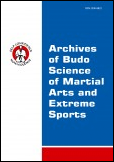2016, Volume 12, Issue 1
Effect of body length, body weight, and sport achievement on points scored by male judo athletes in the Olympic tournament 2012
Stanisław Sterkowicz1, Hans-Dieter Heinisch2, Katarzyna Sterkowicz-Przybycień3
1Department of Theory of Sport and Kinesiology, Institute of Sport Sciences, Faculty of Phys-ical Education and Sport, University of Physical Education in Cracow, Krakow, Poland
2Institute for Applied Training Science in Leipzig, Leipzig, Germany
3Department of Gymnastics and Dance, Institute of Sport Sciences, Faculty of Physical Education and Sport, University of Physical Education in Cracow, Krakow, Poland
Author for correspondence: Stanisław Sterkowicz; Department of Theory of Sport and Kinesiology, Institute of Sport Sciences, Faculty of Phys-ical Education and Sport, University of Physical Education in Cracow, Krakow, Poland; email: stanislaw.sterkowicz[at]awf.krakow.pl
Full text
Abstract
Background and Study Aim: High technical preparation is important for judoka. The aim of this study is knowledge about the association between effects of relative body height, weight category and sport achievement on points scored by judo athletes who use different techniques during their fights.
Material and Methods: The study is based on an analysis of video recordings and a notational analysis of the Olympic men’s tournament 2012 in London. Altogether 252 fights were analysed with the judo specific version (4.5.2) of the video analyse system utilius vs®. Fights of 28 medallists and 28 judo players ranked 5th to 7th were selected for detailed expert video and notational analysis. Three independent values were analysed: relative body height; weight categories combined; level of sport achievement. Dependent value in MANOVA was the efficiency quotient of all relative numbers of own score points collected by each competitor during his fights. Biomechanical classification of techniques was employed. Descriptive statistics were counted and compared between all levels for each factor (statistical significance p<0.05).
Results: A downward tendency of the relative number of all scored points per time (EQ) across consecutive height categories was noticed, but any of pair wise difference between EQ was significant. EQ depended on weight category. Physical lever sub-group techniques were distinguished by higher efficiency when performed by short participants to tall participants, who in place of better scored using “C” techniques (couple of forces throws type).
Conclusions: The top judo athletes adapt techniques to their physique and motor preparation. So, coaches of top athletes and also on lower competitive level could use revealed statistical regularities for their individual development.
Key words: efficiency, elite judo athletes, judo technique, performance, video analyse





